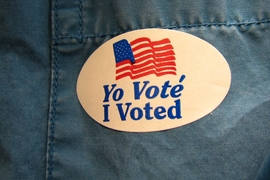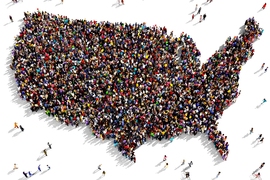On Jan. 10, the MIT Election Data and Science Lab launched as a new enterprise dedicated to researching and improving elections based on scientific principles. The Election Lab will be housed within MIT's School of Humanities, Arts, and Social Sciences (SHASS).
Founded by Charles Stewart III, the Kenan Sahin Distinguished Professor of Political Science at MIT, the lab will address multiple audiences of academic researchers, election practitioners, and the general public. It will serve a unique and independent role as it applies scientific principles to empirical questions about the administration of American elections.
“In the midst of a policy area that has become hyperpoliticized, we aim to provide a counterbalance of hard evidence and analytical thinking," Stewart says. “The Election Lab will serve as an international, nonpartisan resource, with the expertise and evidence necessary to inform improvements of elections.”
Stewart is a renowned expert in how election processes work, how they affect voters, and how they can be improved. A founding member of the influential Caltech/MIT Voting Technology Project (VTP), launched in 2000 to prevent a recurrence of the problems that afflicted that year's U.S. presidential election, he has most recently been applying the principles of queuing theory to the problem of managing voter turnout.
Stewart said he expects the MIT Election Lab to focus in the near future on assessing the overall performance of election administration in 2016, analyzing factors that reduce lines at polling places, and studying the confidence of voters in the election process. "We look forward to bringing together communities in the election administration debate, some of whom often talk past each other, by offering evidence-rich focal points of discussion," Stewart says.
Jean Bordewich, program officer for the William and Flora Hewlett Foundation's Madison Initiative, which provided major funding for the lab, says, “At a fundamental level, the conduct of elections affects the experience of voters and people’s trust in American democracy. It’s imperative that we, as a nation, get this right and we believe that this lab, under Professor Stewart’s leadership, can move us in the right direction.”
MIT SHASS Communications spoke recently with Stewart about his vision and goals for the new MIT Election Lab. In the following interview, readers should note the distinction between the issues that Stewart discusses — which relate to protecting and improving the U.S. election infrastructure (including administration, voting databases, and election equipment) — and other kinds of improprieties seen in the 2016 presidential election. The latter include hacking and releasing emails of U.S. political organizations, as well as the dissemination of “faux news” to influence the electorate. While all aspects of the U.S. electoral process must be protected, the new MIT Election Lab is focused on research that improves the critical voting infrastructure — the official mechanisms, administration, and logistics of the United States electoral system.
Q: What was your motivation for creating the MIT Election Data and Science Lab? What kinds of election problems do you hope the lab will address through its research?
A: The main motivation is my desire to see election procedures and policies developed that have a basis in scientific analysis and not just casual beliefs about how voters interact with the electoral process.
As we’ve just seen in the 2016 presidential election, it is easy for the public — and public officials — to get distracted by sensational charges that the election process is rigged. While we have to worry about that, when voters have problems, it’s mostly for very prosaic reasons. Voting is a complicated system. At MIT we pride ourselves on being able to understand and intervene in complex systems. So, my ultimate goal is to bring the MIT way of thinking to the improvement of election administration.
Q: Why is it important to ensure that elections are not only well run and fair but demonstrably so? Do you think the lab can provide a counter to the problem of misinformation which has increasingly played a part in eroding Americans' faith in their electoral systems?
A: Americans are not yet well informed about the ecosystem of activities that surround the administration of elections. What this means is that when there is a concern about elections, such as the worries that outsiders might have hacked computer systems that help manage elections, Americans think that the whole system is at risk.
The first consequence of that is a general decline in confidence in elections. The second consequence is just as bad — if the public believes that the whole system is at risk, then its leaders aren’t likely to focus in on the specific problems that need to be addressed. Again, the worries in 2016 that the computers that manage elections could be hacked are a good example.
When the news emerged in the fall that computer hackers had infiltrated voter registration systems in two states, most people did not make a distinction between voter registration databases, which are stored software files, and the voting machines that are located in polling places.
As a consequence, a lot of voters became suspicious of the resulting vote count. Many of those voters acted on those suspicions by giving millions of dollars so that ballots could be recounted in Wisconsin, Michigan, and Pennsylvania. And yet, the real problem — which is the vulnerability of voter registration systems to cyber attacks — had nothing to do with the other problem that got the attention — the reliability of voting machines.
I hope some of the work of the Election Lab will be to better educate the general public about the architecture of the election system, so that they know where they should be most concerned about the integrity of the system when alarms are sounded.
Q: Why is MIT the right home for the Election Lab?
A: The Institute has a long history of providing scientific, nonpartisan advice about voting technology and election reform. I once found a letter from the chair of MIT’s Department of Mechanical Engineering to Mayor James Michael Curley of Boston in the 1940s, reviewing the pros and cons of different mechanical lever machines.
Right after the 2000 presidential election fiasco, MIT President Charles M. Vest enlisted a group of us from MIT to help form the Caltech/MIT Voting Technology Project. (President David Baltimore did the same with his colleagues at Caltech.) The VTP was, and continues to be, an interdisciplinary research group that is focused on conducting nonpartisan, scientific research into issues related to election technology and reform.
Understandably, the debate over what the nation should do in response to the 2000 presidential election was fraught with political controversy. The value of the VTP’s work at that time showed up, for instance, in the Help America Vote Act, which was the primary federal response to the controversy. HAVA provided billions of dollars for technology upgrades, which was justified by the work done by the VTP.
We also helped policymakers understand that problems associated with voting weren’t just technological. Many problems were related to the management of complex systems. Once the 2000 controversy blew over, members of the VTP continued to provide scientific advances to the area of voting and elections. For instance, Institute Professor Ronald L. Rivest in Course 6 has become a leader in thinking about new ways to audit the outcome of elections.
In my own case, I have worked with organizations such as the Pew Charitable Trusts to develop objective measures of the quality of election administration. In 2016, I did a lot of work to spread the gospel of queuing theory to state and local election officials, to decrease wait times such as those that caused problems in 2012. (This work was helped by some applications developed by Professor Stephen Graves and his students in Course 15.) Happily, it seems that this work succeeded, and long lines weren’t such a problem last November.
That’s some background on what makes MIT a good home for the Election Lab. And, of course, MIT is trusted around the world because it leads with the facts — which is a breath of fresh air when it comes to election administration.
Story prepared by MIT SHASS Communications
Editorial team: Kathryn O'Neill and Emily Hiestand
!["At a fundamental level, the conduct of elections affects the experience of voters and people’s trust in American democracy," writes the William and Flora Hewlett Foundation in a press release announcing their funding of the MIT Election Data and Science Lab. "It’s imperative that we, as a nation, get this right and we believe that this lab, under Professor [Charles] Stewart’s leadership, ca...](/sites/default/files/styles/news_article__image_gallery/public/images/201701/us-flag-circuits-mit-election-lab-00_0.jpeg?itok=nwzJJCOo)










